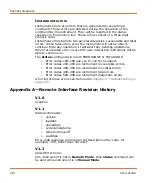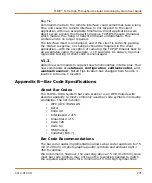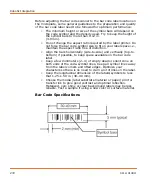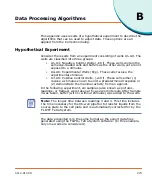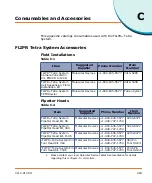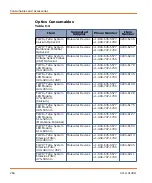
Data Processing Algorithms
274
0112-0109 H
In the table below, the results of the experiment are presented without
Spatial Uniformity Correction, Negative Control Correction, Positive
Control Scaling, or Subtract Bias Value.
An inspection of the fluorescence counts taken at Sample 1 (time = 0)
shows some inter-well variability (range 8000–10000). Variability can
be the result of differences in cell density or well positions (so-called
‘edge effects’ where cells on the outside of the plate are less dense
than their internal neighbors), dye loading, non-uniform illumination,
buffer variations or any other effect which is constant throughout the
experimental run. These variations can complicate data interpretation.
Crosstalk Correction
The crosstalk correction algorithm compensates for light from one well
affecting the read out from a neighboring well.
Determining Crosstalk Correction
If the middle well in the drawing below was empty and the eight wells
surrounding it would have signal, the middle well would show up as
having a certain value based on the amount of light crossing over from
each of it’s neighbors. The percentage of crosstalk from wells directly
next to (B) the well of interest is assumed to be different from the
percentage of the crosstalk from the wells diagonal (A) from the well of
interest, therefore these two values are entered for the crosstalk
correction. In this calculation, only the immediate neighboring wells are
assumed to impact the middle well.
When the crosstalk correction is applied, the Horizontal/Vertical factor
and the Diagonal Factor are applied in a matrix, which automatically
subtracts the percentage of each of the neighboring well’s value from
the middle well’s value. If the crosstalk correction option is selected it
will be the first correction applied to the data. Crosstalk correction is
Sample Time
Well
A1
– Ctrl
A2
– Ctrl
3
– Ctrl
A4
Exp
A5
Exp
A6
Exp
A7
+ Ctrl
A8
+ Ctrl
A9
+ Ctrl
1
0
8000
8500
9500
8200
9200
8800
1000
9500
8700
2
5
8200
8600
9400
8300
9000
9000
9500
9700
9000
3
10
8400
8500
9200
8500
9000
9100
9700
9700
9400
4
20
8600
8400
9200
45000
50000
42000
57000
52000
54000
5
25
8600
8800
9200
37000
42000
35000
53000
50000
50000
6
30
8800
8500
9500
30000
25000
29000
50000
51000
50000
Summary of Contents for FLIPR Tetra
Page 1: ...FLIPR Tetra High Throughput Cellular Screening System User Guide 0112 0109 H December 2011...
Page 12: ...Contents 12 0112 0109 H...
Page 16: ...System Overview 16 0112 0109 H...
Page 40: ...System Hardware Features 40 0112 0109 H...
Page 148: ...Exchanging Hardware 148 0112 0109 H...
Page 156: ...Calibration and Signal Test 156 0112 0109 H...
Page 196: ...Running an Experiment 196 0112 0109 H...
Page 232: ...Robotic Integration 232 0112 0109 H The following drawings illustrate these requirements...
Page 282: ...Data Processing Algorithms 282 0112 0109 H...
Page 294: ...Consumables and Accessories 294 0112 0109 H...
Page 298: ...Using AquaMax Sterilant 298 0112 0109 H...
Page 302: ...Electromagnetic Compatibility EMC 302 0112 0109 H...











